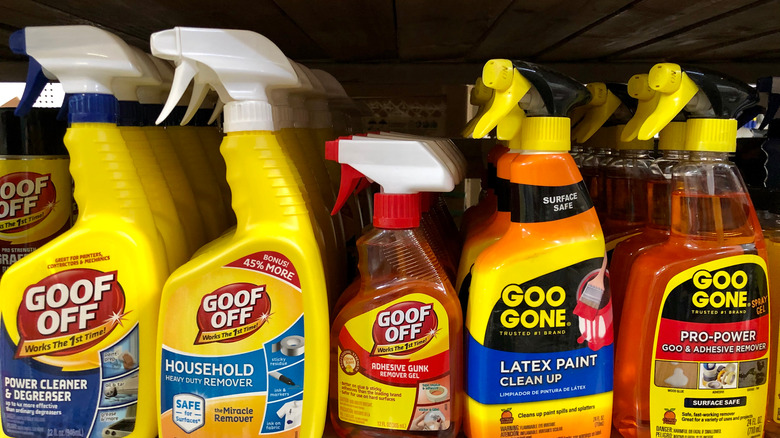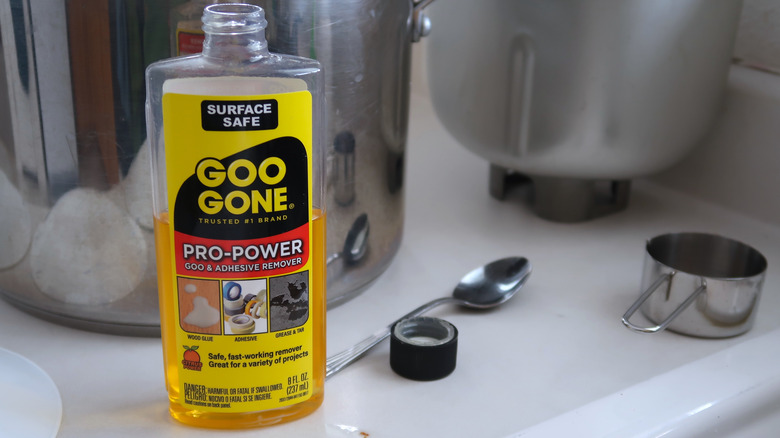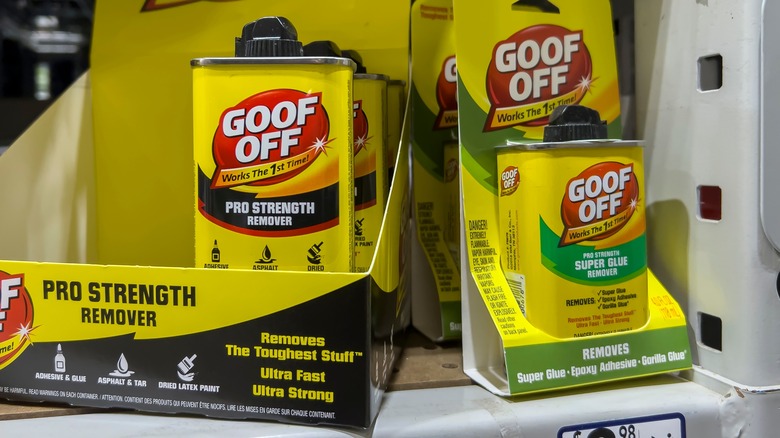Goo Gone Vs. Goof Off: What's The Difference?
While there are plenty of tools to help clean your home and others that make car-cleaning a breeze, nothing quite beats a good heavy-duty solution for hard-to-remove gunk. And few solutions are as well-suited to tackle such problems as Goo Gone and Goof Off. These high-quality cleaning agents have been trusted by countless professionals, DIYers, and homeowners to clean up tough messes from a variety of surfaces. But what may not be apparent to the naked eye are the differences that come with both products.
It's easy to confuse Goo Gone with Goof Off and not think much of it. Both have similar names, sport near identical colors, and perform more or less the same tasks. But despite these similarities, it's important to keep their unique distinctions in mind when figuring out which will work best for your job. In short, Goo Gone is a mild solution for taking off lighter residue, whereas Goof Off is a heavy-duty cleaner for more robust purposes. Within that simple framework are a number of nuances that go into the overall effectiveness of these products for their respective duties. Let's dive into some of those notable differences to better help you figure out which one of these cleaning solutions will work best for you.
What is Goo Gone best for?
As we stated earlier, the key thing to keep in mind with Goo Gone is that it's intended for lighter-duty jobs. On the company's website, you can find a wide variety of product lines with the Goo Gone name, ranging from the Goo Gone Original for more general use to Goo Gone Latex Paint Clean Up for removing paint and varnish from various surfaces to Goo Gone Pro Power for more industrial level jobs. They come in different forms, including clean up wipes, spray gels, goos, and even applicator pens.
Goo Gone is ideal to use on less aggressive messes and adhesives, especially if you want to avoid causing damage to a particular surface. While ingredients vary between different products, the main active components of Goo Gone include petroleum distillates, aliphatic ether alcohol, d-Limonene, polymer, orange sweet extract, solvent orange 60, and solvent red 18. These ingredients work together to break down grime, fight bacteria, and leave a fresh scent, all while effectively interacting with common household surfaces such as woods, plastics, glass, or ceramics without worry of any damage.
While great at taking off paints, grease, tree sap, ink, and wax, it will have a harder time removing tougher material such as rust, graffiti, or superglue. It's also worth keeping in mind some of the potential hazards that come with Goo Gone if used improperly. It received a score of F from the Environmental Working Group due to many of its ingredients, particularly petroleum distillates, being linked to respiratory and vision damage, organ issues, and even cancers.
What is Goof Off best for?
Goof Off is another brand with no shortage of product offerings. Like Goo Gone, you'll find Goof Off products ideal for paint, automotive cleaning, and general messes, but it also sports some heavier-duty solutions such as removers for graffiti, rust stains, tar, and more. Users have compared some of their products more to gels as opposed to Goo Gone sprays and removers which are a much thinner liquid.
While you can use Goof Off in most common household and car cleaning scenarios, it's a product that's especially well-suited for those with more professional level tasks, meaning people who regularly clean harsher messes from tougher materials such as metal, concrete, or brick. The active ingredients in your typical Goof Off product include abrasive elements such as cumene, stoddard solvent, methanol, acetone, xylene, ethylbenzene, and morpholine.
As you can imagine, there are some significant potential risks that come with being exposed to these chemicals. This is another brand with an F rating from the Environmental Working Group as well as a Proposition 65 Warning for Californians, as Goof Off presents potential issues that can range from skin and allergy irritation to cancer and birth defects. The corrosive nature of the chemical mixture that makes up Goof Off also has the potential to damage surfaces such as car paint if overused.


